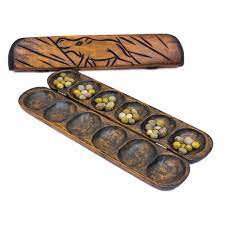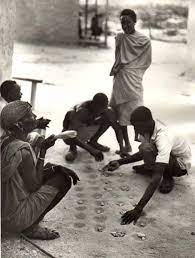TECHNICALITIES OF AYO GAME
The board is about 0.8m to 1.2m long with twelve holes as field of play having six holes on each side of the board. The game is played in such a way that each of the two players moves the seeds in turn and drops one each in the holes starting from the next hole from which the seed(s) are removed ,moving in an anticlockwise direction, until all the seed(s) removed have being exhausted. Only one seed can be moved to the next hole .You can only move seed(s) from your own side. There may be one hole on each side of the board for counters. The game will be played with four (4) seeds in each hole of play; a total of forty-eight (48) seeds with twenty-four (24) on each side of the playing board. 'AYO' is believed to be one of the oldest Traditional Sports that bears different names in different countries in Africa . In Nigeria , it became a demonstration sport at Benue 96, a scoring event at Imo 98 producing two gold medals. At Bauchi 2000 it produced 3 gold medals. At Edo 2002, it produced 5 gold medals, Also at Abuja 2004 and Gateway 2006; it produced 5 gold medals respectively. It was demonstrated at the 8th All Africa Games through the approval of SCSA and COJA.

HOW TO PLAY:
This two player game runs counter-clockwise. Players can only pick up seeds from their side of the board, unless they are “capturing” seeds from the opponent’s side of the board. The objective is to “capture” all your opponent’s seeds. Step 1- The first player begins by picking up all of the seeds from one of their holes, and running them counter-clockwise. Step 2- The opponent does the same, starting from their side. Step 3- If the seed movement ends in a hole with four Ayo seeds on the opponent’s side, the player “captures” those seeds. Step 4- When this happens, they win one “house” and remove the seeds from the game. Step 5- The opponent must always choose their move to bring one or more seeds into the other’s row. Step 6- Players take turns until the seeds are exhausted. Step 7- If a player records three straight wins, they become a champion (ota). The loser (ope) quits, and a new player then takes over.

In summary, African games should be encouraged and played often. It helps in preserving our culture and promoting African unity.
